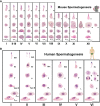Updates in Sertoli Cell-Mediated Signaling During Spermatogenesis and Advances in Restoring Sertoli Cell Function
- PMID: 35600584
- PMCID: PMC9114725
- DOI: 10.3389/fendo.2022.897196
Updates in Sertoli Cell-Mediated Signaling During Spermatogenesis and Advances in Restoring Sertoli Cell Function
Abstract
Since their initial description by Enrico Sertoli in 1865, Sertoli cells have continued to enchant testis biologists. Testis size and germ cell carrying capacity are intimately tied to Sertoli cell number and function. One critical Sertoli cell function is signaling from Sertoli cells to germ cells as part of regulation of the spermatogenic cycle. Sertoli cell signals can be endocrine or paracrine in nature. Here we review recent advances in understanding the interplay of Sertoli cell endocrine and paracrine signals that regulate germ cell state. Although these findings have long-term implications for treating male infertility, recent breakthroughs in Sertoli cell transplantation have more immediate implications. We summarize the surge of advances in Sertoli cell ablation and transplantation, both of which are wedded to a growing understanding of the unique Sertoli cell niche in the transitional zone of the testis.
Keywords: AR signaling; Exosome extracellular vesicle (EV); FSH signaling; Sertoli cell ablation; Sertoli cell transplantation; Spermatogenesis; sertoli cell (SC) niche; transitional zone (TZ).
Copyright © 2022 Ruthig and Lamb.
Conflict of interest statement
DJL serves on the Ro advisory board, and as a consultant, and has equity; and for Fellow has equity; and serves as Secretary-Treasurer for the American Board of Bioanalysts with honorarium. The remaining author declares that the research was conducted in the absence of any commercial or financial relationships that could be construed as a potential conflict of interest.
Figures


References
-
- Russell LD, Ettlin RA, Sinha Hikim AP, Clegg ED. Histological and Histopathological Evaluation of the Testis. St. Louis, MO: Cache River Press; (1990).
-
- Russell LD, Griswold MD. The Sertoli Cell. Clearwater, FL: Cache River Press; (1993).
-
- Russell LD, Ren HP, Sinha Hikim I, Schulze W, Sinha Hikim AP. A Comparative Study in Twelve Mammalian Species of Volume Densities, Volumes, and Numerical Densities of Selected Testis Components, Emphasizing Those Related to the Sertoli Cell. Am J Anat (1990) 188:21–30. doi: 10.1002/aja.1001880104 - DOI - PubMed
-
- Tung PS, Fritz IB. Morphogenetic Restructuring and Formation of Basement Membranes by Sertoli Cells and Testis Peritubular Cells in Co-Culture: Inhibition of the Morphogenetic Cascade by Cyclic AMP Derivatives and by Blocking Direct Cell Contact. Dev Biol (1987) 120:139–53. doi: 10.1016/0012-1606(87)90112-6 - DOI - PubMed
Publication types
MeSH terms
Grants and funding
LinkOut - more resources
Full Text Sources
Medical
Research Materials

